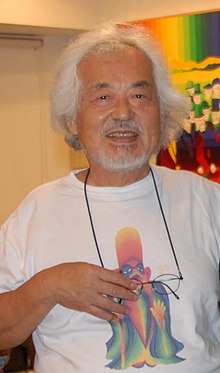Ay-O
| Ay-O | |
|---|---|

Ay-O at Gallery Itsutsuji
|
|
| Born |
Takao Iijima May 19, 1931 |
| Nationality | Japanese |
| Known for | Painter |
Takao Iijima (born May 19, 1931), better known by his art name Ay-O, (靉嘔) is a Japanese artist who has been associated with Fluxus since its international beginnings in the 1960s.
Probably, the best reference to understand the early years of Ay-O is the autobiographical retrospective book in the references "Ay-O, Over the Rainbow, Ay-O Restrospective 1950-2006." In a nutshell: Ay-O started his career in the Demokrato Artist Association (デモクラート美術家協会), created by Ei-Q. This association promoted artistic freedom and independence in making art. The influence of these values with Ay-O can be seen in a series of early paintings over which he painted a large X because he thought they were not original enough. Another independent movement was close to Democrato in Japan: Sōzō Biiku (創造美育) by the collector Sadajirō Kubo (久保貞次郞) promoting nurturing freedom when teaching art. Both movements started Fukui Prefecture in Japan and explain the special bound Ay-O developed with the Fukui Prefecture. Sōzō Biiku's approach is a challenge of the traditional Japanese Master-Student relationship. As such, like naive art, the movement promotes ways independent to the culturally established ones. Kubo also created the "Small Collector Society" (小コレクターの会) to spread art collection in society. Some of the works from this period in the 50s show an influence from Fernand Léger with massive bodies on the canvas (like for example the massive (1.83mx3.7m) Pastoral (Den'en) from 1956 [1][2]).
Ay-O was introduced to George Maciunas by Yoko Ono in 1961 and formally joined Maciunas in Fluxus in 1963. Ay-O was known for his Finger Boxes and for his performance events when he was active in Fluxus. He worked closely with fellow Fluxus artists Maciunas, Emmett Williams, Dick Higgins and Nam June Paik. Ay-O and Nam June Paik were roommates (and became friends) in this Soho fluxus style coop at the time.
...
Wikipedia
